 |
|---|
|
|
Regional elections were held in Denmark in March 1935. 299 members of the county councils of Denmark were elected.
 |
|---|
Regional elections were held in Denmark in March 1935. 299 members of the county councils of Denmark were elected.
The results of the regional elections: [1]
| Party | Votes | % | Seats | |
|---|---|---|---|---|
| Venstre | 217,375 | 37.72 | 124 | |
| Social Democrats | 149,896 | 26.01 | 85 | |
| Conservative People's Party | 85,808 | 14.89 | 40 | |
| Danish Social Liberal Party | 65,641 | 11.39 | 27 | |
| Farmers' Party | 16,270 | 2.82 | 6 | |
| Justice Party of Denmark | 15,408 | 2.67 | 1 | |
| National Socialist Workers' Party | 9,634 | 1.67 | 3 | |
| Schleswig Party | 4,737 | 0.82 | 6 | |
| Communist Party of Denmark | 824 | 0.14 | – | |
| Others | 10,715 | 1.86 | 7 | |
| Total | 576,308 | 100.00 | 299 | |
| Registered voters/turnout | 858,970 | – | ||
| Source: Danmarks Statistik | ||||
There are three types of elections in Denmark: elections to the national parliament, local elections, and elections to the European Parliament. Referendums may also be called to consult the Danish citizenry directly on an issue of national concern.
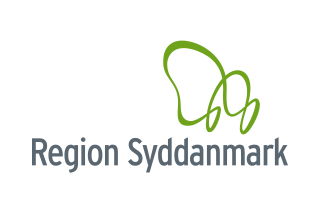
The Region of Southern Denmark is an administrative region of Denmark established on Monday 1 January 2007 as part of the 2007 Danish Municipal Reform, which abolished the traditional counties ("amter") and set up five larger regions. At the same time, smaller municipalities were merged into larger units, cutting the number of municipalities from 271 before 1 January 2007 to 98. The reform diminished the power of the regional level dramatically in favor of the local level and the central government in Copenhagen. The Region of Southern Denmark has 22 municipalities. The reform was implemented in Denmark on 1 January 2007, although the merger of the Funish municipalities of Ærøskøbing and Marstal, being a part of the reform, was given the go-ahead to be implemented on Sunday 1 January 2006, one year before the main reform. It borders Schleswig-Holstein (Germany) to the south and Central Denmark Region to the north and is connected to Region Zealand via the Great Belt Fixed Link.
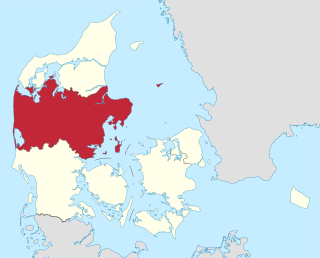
The Central Denmark Region, or more directly translated as the Central Jutland Region and sometimes simply Mid Jutland, is an administrative region of Denmark established on 1 January 2007 as part of the 2007 Danish municipal reform. The reform abolished the traditional counties (amter) and replaced them with five new administrative regions. At the same time, smaller municipalities were merged into larger units, cutting the total number of municipalities from 271 to 98. The reform diminished the power of the regional level dramatically in favour of the local level and the national government in Copenhagen. The Central Denmark Region comprises 19 municipalities.
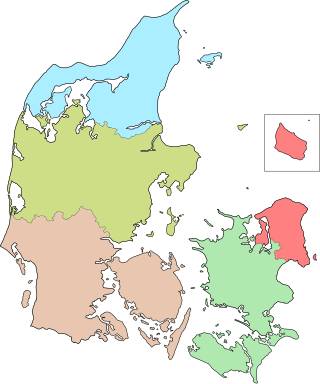
The five Regions of Denmark were created as administrative entities at a level above the municipalities and below the central government in the public sector as part of the 2007 Danish Municipal Reform, when the 13 counties (amter) were abolished. At the same time, the number of municipalities (kommuner) was cut from 270 to 98. The reform was approved and made into a law by the lawmakers in the Folketing 26 June 2005 with elections to the 98 municipalities and 5 regions being held Tuesday 15 November 2005.

The National Socialist Movement of Denmark is a neo-Nazi political party in Denmark. The movement traces its origins back to National Socialist Workers' Party of Denmark, the Danish Nazi party founded in the mid-1930s, more or less as a copy of Adolf Hitler's German NSDAP. After the end of the Second World War, a few people continued under the original party name, and published the newspaper Fædrelandet during the period 1952–1972. The movement was dissolved, reformed, and renamed several times between 1972 and 1991. The current incarnation of Danmarks Nationalsocialistiske Bevægelse was founded on 1 September 1991 by Jonni Hansen.
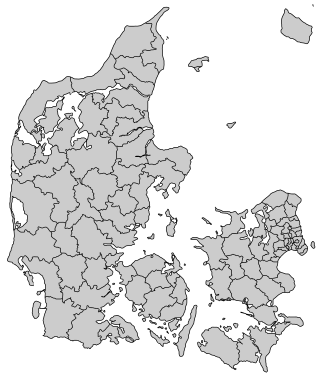
Denmark is divided into five regions, which contain 98 municipalities. The Capital Region has 29 municipalities, Southern Denmark 22, Central Denmark 19, Zealand 17 and North Denmark 11.

Local elections were held in Denmark on 17 November 2009. Councils were elected in Denmark's 98 municipalities and the five regions. 2468 seats were contested in the municipal elections. 205 seats were contested in the regional elections.
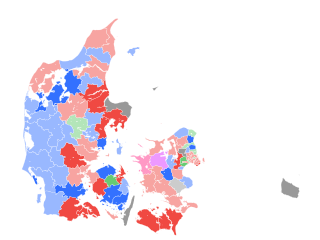
Local elections were held in Denmark on 15 November 2005. 2522 municipal council members were elected in Denmark's 98 municipalities and 205 regional council members in the five regions. Most of these were newly formed municipalities, namely 66 municipalities, that would only begin working from Monday 1 January 2007, as would the newly formed regions, and one municipality, Ærø, which was also part of the reform, which was allowed by the government to commence work for the first time already Sunday 1 January 2006. So the first term of office in this newly created municipality was the whole period of four years from 2006 until 2009. The reform was approved 26 June 2005 by the lawmakers in the Folketing and signature by the head of state (when?). The 238 municipal councils and 13 county councils that were to be abolished 1 January 2007 just continued their work one year more than the term of office (2002-2005) they were elected for until 31 December 2006 and then ceased to exist. Among the remaining 31 municipalities having their new councils elected was Bornholm Regional Municipality that was formed and began its work 1 January 2003. This was only the second time it had a new council elected, the first time being on 29 May 2002, and it was the first time its council served the whole term of office. Bornholm's merger was not a part of the reform, having been decided by the island's voters already on 29 May 2001. It was the new center-right government elected at the end of 2001 that drove the reform through parliament. The 30 municipalities that remained were not merged with other municipalities, so their newly elected councils served the whole term of office 1 January 2006 until 31 December 2009.
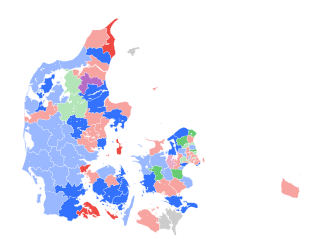
Local elections were held on 19 November 2013 in Denmark's 98 municipal councils, contesting 2,444 seats for the 2014–2017 term of office, and in five regional councils, contesting 205 seats for the 2014–2017 term. Advance voting began on 20 August 2013 in national registration offices in Denmark, hospitals, prisons, etc. Twelve women held the highest political office of mayor in the municipalities in the 2014–2017 term of office.
Local elections were held in Denmark on 20 November 2001. 4647 municipal council members were elected to 275 municipal councils, as well as members of 14 counties of Denmark. There were 14 counties and 275 municipalities, but the county of Bornholm was merged with its 5 constituent municipalities 1 January 2003 to form Bornholm Regional Municipality. The voters of Bornholm voted in these elections in the soon to be dissolved municipalities and county, but later elected the councillors in a local election 29 May 2002 to lead the newly formed municipality from January 2003. The county and county council of Bornholm just continued its work until 2002 while the new Bornholm Regional Municipality was being built from the 6 old entities. From 1 January 2003 until 31 December 2006, Bornholm was both a municipality and a county, thereafter becoming a part of Region Hovedstaden and losing most of its county privileges.
Regional elections were held in Denmark on 21 November 1989. 4737 municipal council members were elected to the 1990–1993 term of office in the 275 municipalities, as well as 374 members of the 14 counties of Denmark.
Regional elections were held in Denmark on 3 March 1970. 4677 municipal council members were elected to the 1970 - 1974 term of office in the 277 municipalities, as well as 366 members of the 14 counties of Denmark. The term of office was 1 April 1970 - 31 March 1974. In Copenhagen County Sengeløse was created a municipality from 1 April 1970, but existed only until 31 March 1974. It was abolished 1 April 1974, becoming part of Høje-Taastrup Municipality. Store Magleby parish municipality merged with Dragør parish municipality to become Dragør Municipality from 1 April 1974. From 1 April 1974 there were 275 municipalities in Denmark.
Regional elections were held in Denmark on 4 March 1958. 11529 municipal council members were elected, as well as 303 members of the amts of Denmark.
Regional elections were held in Denmark on 2 March 1954. 11505 municipal council members were elected, as well as 299 members of the amts of Denmark.
Regional elections were held in Denmark on 14 March 1950. 11499 municipal council members were elected, as well as 299 members of the counties of Denmark.
Regional elections were held in Denmark on 12 March 1946. 11488 municipal council members were elected, as well as 299 members of the amts of Denmark.
Regional elections were held in Denmark on 5 May 1943. 10569 municipal council members were elected, as well as 299 members of the amts of Denmark.
In the amts of Southern Jutland, there wasn't an election in 1943, but the numbers from the previous election were recorded again.

Local elections were held on 21 November 2017 for Denmark's 98 municipal councils and five regional councils. All 2,432 seats were contested for the 2018–21 term of office, together with 205 seats in five regional councils. In the previous election, there were 2,444 seats in the municipal councils.

Local elections were held in 2021 for Denmark's 98 municipal councils and five regional councils. All 2,436 seats were contested for the 2022–2025 term of office, together with 205 seats in five regional councils. Frederiksberg Municipality had increased their number of councillors from 25 to 29.